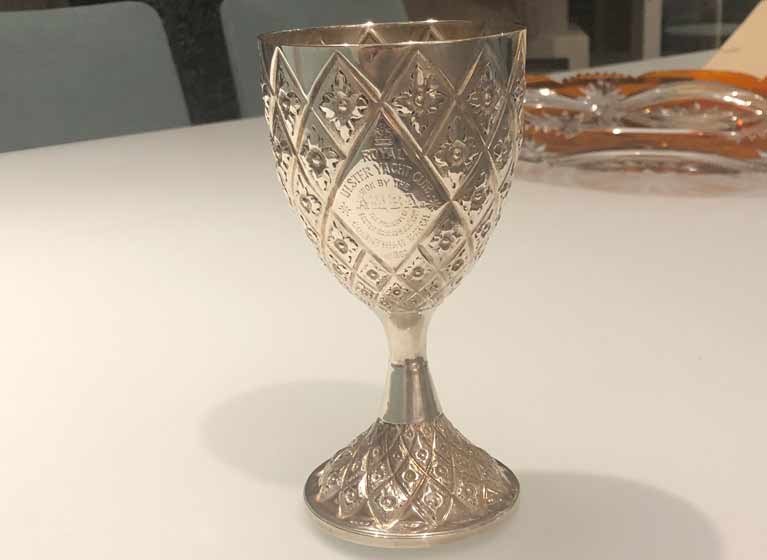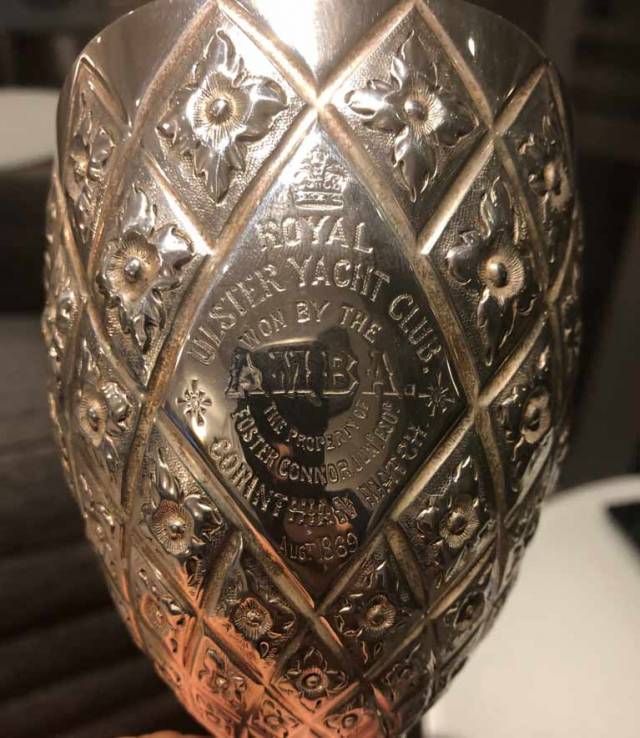Recently Royal Ulster Yacht Club was contacted by a Mr Andre Jaku of Melbourne, Australia about a goblet he had bought from Leonard Joel’s Auction house in the city.
It was listed as silver and was engraved with the words:
Royal Ulster Yacht Club
Won by the AMBA The property of Foster Connor Jun Esq.
Corinthian Match Aug 1869
It appears slightly repaired on the stem and there is a small mark on the bottom. I understand from the club historian, Ed Wheeler, that it is the trophy for the race between Amba owned by Mr Connor and Mr John Currell’s Flirt.
According to the Club history, Foster Connor seems to have become a member in 1869 and this was the year in which the Club received its Royal warrant (ie its name changed from the Ulster Yacht Club to the Royal Ulster Yacht Club). Interestingly, this did not come officially into force until a meeting on 14th October at which the warrant was received and the name change took place. So, the date on the goblet, August 1869, precedes the date on which the Club became RUYC, so the inscription may be misleading, although the trophy could have been awarded and inscribed after the warrant was formalised.
Connor’s 9-ton cutter Amba and John Currell’s 7-ton cutter Flirt seem to have been the leading protagonists.
 The RUYC Trophy with an Australian twist
The RUYC Trophy with an Australian twist
Ed Wheeler reveals that Currell and Connor were having some kind of feud at the time and at a committee meeting a letter was read out from Foster Connor, in which he declined to accept the jurisdiction of the “three gentlemen who proposed to decide a question in dispute on that occasion”. At the meeting, he said that the Protest Committee was not properly constituted because not all of the Sailing Committee had been invited and of the three who were, two were brothers, so he would not abide by their decision. Mr. Richard Patterson then said that, before the race started, Mr. Connor had told him that he would not be bound by any decision the race committee might make; he then said that the reason they agreed to go before the two members on the committee after the race was because they were sure that the decision would go in their favour.
Connor was Rear Commodore of RUYC in 1884 and his son, Charles C Connor held the same position in 1891. Although the details of the race for which the cup was awarded in 1869 are not known, the following year a similar race took place. This was a “Corinthian” race, meaning a race for amateur sailors only, for yachts of 10 tons or under. Cups awarded for club races in those days were mainly “keepers”, rather than perpetual challenge cups, which is why the cup is marked as Foster Connor’s property.
/more
There are several occasions in which a Mr Foster Connor is mentioned in records.
And from those he would appear to have been a wealthy man, owning two residences, one in Belfast and a grand mansion called Seacourt which he built at Wilson’s Point on the west of Bangor Bay. In the Dept of Communities Historic Buildings it is included as “A grand symmetrical, classically-styled, two-storey three-bay house over concealed basement, built c.1865, located to the north side of Bangor, overlooking the sea and in 1860 the Journal of the Society of Arts named Foster Connor and Co as one of the six principal linen manufacturers in Belfast. He was also a keen yachtsman. (Journal of Society of Arts; Hunt’s Yachting Magazine) Connor died in 1881 and the house then passed to his son Charles C Connor”
In a Belfast Street Directory, he is listed as a linen merchant and yarn merchant with a residence in Linenhall Street, Belfast.
Connor is buried with other family members in the Belfast City Cemetery with an 8ft high headstone described as a
Memorial to the Foster Connor (died 5th December 1881 aged 70 years) as well as other members of his family.
Foster Connor was a wealthy linen merchant who lived in Belfast but also had the fine residence Seacourt built for him at Wilson's Point, Bangor.
So, the question is how did the goblet come to be in Melbourne?


























































